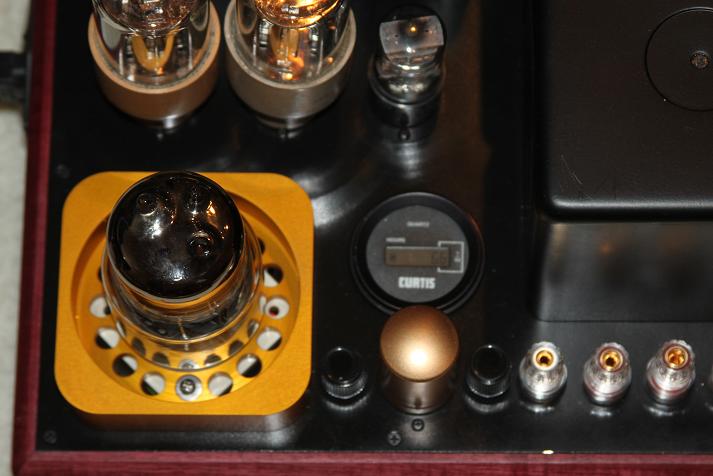Rerurn to Romy the Cat's Site
In the Forum: Melquiades Amplifier
In the Thread: A different breed of 6C33C amplifier.
Post Subject: 6C33C ampPosted by KOTriode on: 9/7/2011
fiogf49gjkf0d

Thank you for the comment on this amp, this is my first time of using the 6C33C tube, I decided to build this amp after reading about the Melquiades, this amp is just a quick experiment on the 6C33C sound, since I have a single chassis intended for a phono/preamp laying around for year now, normally I would build a mono block. I picked up 4 these tubes for less than $50 on my trip to Asia last year, they are harder to find now over there, why? nobody care of these cheap tubes, so nobody stock them any more.
- Vaccum tube rectification/regulator in amplifier: Yes, there is quite a few debate on these subject. Two years ago after building a 845/WE212E amplifier with tube rectification/regulator (yes, with 1200V regulator), and compare the sound with previous rectification/unregulated 845 amplifier, I would never go back. With this 6C33C amp, I have made an extra step in this experiment, using the same tube in the amplifier for the regulator, so that the regulator tube do not add it's own tube sonic signature (I normally used 6AS7 in other regulator). Also, with tube regulator, I did not have to use too much capacitance, and do without choke, saving amplifier real estate and weight. Another strong point for regulator: I can adjust B+ anywhere from 160-220V, and with adjustable bias on the tube from 100ma-300ma, I should be able to find its sweet spot.
- Direct coupling: I used expensive Tango NC20 in my other 845/212E amplifier and was very happy about its sound. I used a lesser interstage in the $500 range on my 300B and was not impressed. So, not willing to buy another pair of NC20 (by the way, a pair of NC20 went for $2300 on Ebay last month) for this 6C33C (cheap) amplifier, I decided on direct coupling (it's free, and I dont have to look for expensive coupling capacitor). For safety, I used a 500ma fuse on the plate. A cathode bias method would have been safer, but with over 30W of heat from cathode bias resistor under the hood will make this amp short lived.
- Input/driver: It's a plate follower direct coupled to a cathode follower. This amp actually only need 1 stage, I installed two sockets just in case (you always need to have plan B) if one stage is not adequate. I threw in the cathode follower stage as an experiment, if I do not like the sound it can be easily removed an replace with a jumper (then, an eye tube will take its place).
It's still too early to tell how this amp sound, as of last night the meter showed only 6.6 hours of break in time (you can barely see the hrs above the "Curtis" hour meter. So far I learned that one of the brand new tube failed with properly heater burn in, it needed -125V bias instead of around -70V. I also learned from the tube seller that you need burn-in 24 hrs just for the heater on these virgin tubes before applying any current. This amp run really hot, the whole chassis get hot, I installed an fan under each power tubes and and it helped a lot. I should able to tell the sound of this tube after about 100hrs on the meter.Rerurn to Romy the Cat's Site